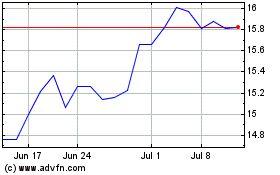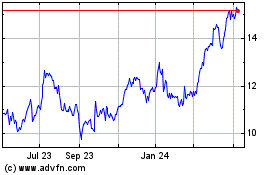By Jenny Strasburg and Eyk Henning
Executives at Deutsche Bank AG are contemplating dramatic
options for the German lender, including selling all or part of a
key business, a sign of growing pressure to speed up a flagging
overhaul.
This weekend, senior executives are meeting to debate some of
these options, according to people familiar with the plans. One has
already been floated: a merger with Germany's second-largest bank
by market value, Commerzbank AG, the people said. Deutsche Bank and
Commerzbank held preliminary discussions about a tie-up in August,
before concluding last week it wasn't viable.
Chief Executive John Cryan, who was named co-CEO in July 2015,
has set out a long-term plan of shrinking Deutsche Bank and cutting
costs. But the merger discussions and the weekend summit signify
that the bank may not have the luxury of a drawn-out revamp. On
Wednesday, Mr. Cryan found himself on stage at a financial
conference in Frankfurt batting back speculation about a
merger.
For Deutsche Bank, 2016 has been an annus horribilis. Its shares
are off 41% this year and now trade where they did in the
mid-1980s. It has a long list of regulatory troubles compounded by
a thin capital cushion and flagging performance in many key
business lines that leave it more vulnerable than its peers.
To make matters worse, Britain's vote to leave the European
Union rattled confidence across Europe's financial sector and posed
problems for banks with large London workforces. Deutsche Bank runs
big trading, advisory and asset-management operations from London
and has more than 8,000 employees in the U.K., where it books
almost 20% of its revenue, more than many non-U.K. peers.
Since the June 23 vote, Deutsche Bank's shares are down 15%,
more than twice the decline of eurozone banks broadly. Shares in
troubled rival Credit Suisse Group AG are down 2% since Brexit.
Deutsche Bank's market value is around $20 billion, a bit bigger
than Buffalo, N.Y.-based M&T Bank Corp. Its profit in the
second quarter fell 98%, to EUR20 million ($22.3 million), or
around $200 per employee.
Deutsche Bank was once an ambitious powerhouse. It was a top
deal maker across the continent and one of the few big European
players competing head-on with the biggest U.S. banks on their
turf. But this year has been humbling -- and Deutsche Bank seems to
have few good options.
Mr. Cryan and other top executives have expressed aversion to a
merger, people familiar with internal bank discussions said. He,
like many analysts and investors, has said that regulatory hurdles
alone could make such a tie-up far-fetched.
Instead, Mr. Cryan, who became sole CEO earlier this year, has
pushed to go it alone. In October, he unveiled new financial
targets and a five-year overhaul plan.
That was before European banks had to face the increasing pain
of lower and negative interest rates. That squeezes profits in
retail banking.
As part of a continuing review of strategic options, the bank in
recent weeks has analyzed possibilities including selling all or
part of its asset-management business, people close to the matter
said. Deutsche Bank executives want to keep most of the business,
the people say. They see the steady returns as ballast against
volatile profits from the bigger trading and investment-banking
businesses.
But small pieces of the asset-management division could be
deemed ripe for sale, people briefed on internal discussions
said.
Deutsche Bank executives also are discussing whether to adjust
Mr. Cryan's October financial targets, such as profit goals, the
people said.
"We do have confidence in the management team," says Laurie
Mayers, a European banking analyst with Moody's Investors Service.
"But Brexit is unwelcome additional pressure when they already have
quite important issues to address."
Moody's rates Deutsche Bank Baa 2, two notches above junk level.
One factor: the lender's heavy dependence on its trading
business.
That business has been under pressure this year. In May, the
bank's finance chief told a large investor that about two dozen
trading clients had capped the volume of their trades with the
bank, according to a person familiar with the conversation.
Deutsche Bank said client activity subsequently picked up.
Deutsche Bank is a tough ship to turn around. It has big
business lines in sales and trading of stocks and bonds --
once-lucrative zones that have shrunk amid regulatory change and
stiff competition. Its retail-banking business is concentrated in
Germany, a cutthroat market full of regional savings banks.
And Deutsche Bank has a massive book of hard-to-value
derivatives. The riskier derivatives have become harder to sell
after Brexit, analysts say. Since 2007, the bank has culled its
so-called "Level 3" assets, which include distressed debt and
complex derivatives, to EUR29 billion as of the second quarter, a
67% decrease from 2007.
But Level 3 assets still equate to about 47% of shareholder
equity, a ratio much higher than at the biggest U.S. investment
banks.
Thanks in part to these exposures, the International Monetary
Fund this summer called Deutsche Bank the No. 1 contributor to
systemic risk among the biggest global banks. And soon after, in
stress tests, European regulators concluded that Deutsche Bank
would have enough capital to withstand a severe downturn -- but
only barely.
Such developments have led investors to ask: Will Deutsche Bank
have enough capital to absorb possible trading losses or
outstanding fines? And is it moving fast enough to reach that
point?
Deutsche Bank needs to generate about EUR7 billion in capital by
2019, analysts say. Building capital "organically," as Mr. Cryan's
team wants to do, is hard work: The bank must improve earnings and
conserve them. Shareholders also have been put off by the
elimination of two years of dividends.
Bank executives don't want to sell new shares to raise capital,
Citigroup banking analyst Andrew Coombs said in a recent note, but
there might not be a choice. "Capital concerns won't go away," he
wrote.
--Madeleine Nissen contributed to this article.
Write to Jenny Strasburg at jenny.strasburg@wsj.com and Eyk
Henning at eyk.henning@wsj.com
(END) Dow Jones Newswires
August 31, 2016 16:59 ET (20:59 GMT)
Copyright (c) 2016 Dow Jones & Company, Inc.
Commerzbank (PK) (USOTC:CRZBY)
Historical Stock Chart
From Mar 2024 to Apr 2024

Commerzbank (PK) (USOTC:CRZBY)
Historical Stock Chart
From Apr 2023 to Apr 2024
